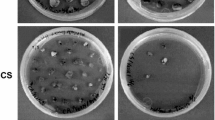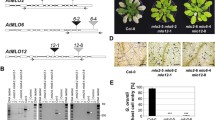Abstract
Endophytes, bacterial, fungal or viral, colonize plants often without causing visible symptoms. More important, they may benefit host plants in many ways, most notably by preventing diseases caused by normally virulent pathogens. Craigella tomatoes (Lycopersicon esculentum Mill.) can be infected with Verticillium dahliae Kleb., either race 1 (Vd1) or a non-host isolate Dvd-E6 resulting in susceptibility or tolerance, respectively. The present study sought to determine whether Dvd-E6 is endophytic and can protect tomato against Vd1. The total amount of Verticillium in stems and roots was determined by quantitative PCR; the relative amounts of Vd1 and Dvd-E6 were assessed by restriction fragment polymorphism. When Dvd-E6 infects before or together with Vd1, Vd1 is excluded almost completely from the root but, when Vd1 infects first, Dvd-E6 can compete on an equal basis. Previous studies suggested that Dvd-E6 suppresses symptom-related genes, raising the possibility that Dvd-E6 simultaneously induces tolerance to Vd1. This does not seem to be entirely the case since the minimal symptoms following Vd1 infection of Dvd-E6 tolerant Craigella result, at least in part, from restricted Vd1 colonization. Furthermore, when Vd1 and Dvd-E6 are cultured on PDA plates alone or together, the growth rates are similar and neither is inhibitory to the other. Dvd-E6 does not outgrow or inhibit Vd1, in vitro. The protective effect apparently requires interplay between Dvd-E6 and the plant. Expression analyses of tomato genes involved in resistance and defence support this interpretation.









Similar content being viewed by others
Abbreviations
- BP:
-
Base pair
- CDK:
-
Cyclin dependent kinase
- CS:
-
cv Craigella susceptible
- Dpi:
-
Days post-inoculation
- E6:
-
V. dahliae isolate Dvd-E6
- ITS:
-
Internal transcribed spacer
- PR:
-
Pathogen-related
- PCR:
-
Polymerase chain reaction
- RT:
-
Reverse transcription
- SDS:
-
Sodium dodecylsulphate
- Vd1:
-
Verticillium dahliae race 1
References
Abeyrathne PD, Nazar RN (2000) Plasmid-enhanced strategy for PCR-mediated mutagenesis with difficult DNA templates. BioTechniques 29:1172–1174
Alba R, Fei Z, Payton P, LiuM Y, Moore S, Debbie P, Cohn J, D’Ascenzo M, Gordon J, Rose J, Martin G, Tanksley S, Bouzayen M, Jahn M, Giovannoni J (2004) EST’s, cDNA microarrays, and gene expression profiling: tools for dissecting plant physiology and development. Plant J 39:697–714
Bishop CD, Cooper RM (1983) An ultrastructure study of root invasion in three vascular wilt diseases. Physiol Plant Pathol 22:15–27
Bonshtien A, Lev A, Gibly A, Debbie P, Avni A, Sessa G (2005) Molecular properties of the Xanthomonas AvrRxy effector and global transcriptional changes determined by its expression in resistant tomato plants. Mol Plant Microbe Interact 18:300–310
Busch LV, Smith E (1981) Susceptibility of Ontario-grown alflafa cultivars and certain Medicago species to Verticillium albo-atrum. Can J Plant Pathol 3:169–172
Chen P (2003) Tolerance to a non-host isolate of Verticillium dahliae. MSc thesis Molecular Biology and Genetics. University of Guelph, Guelph, p 111
Chen P, Lee B, Robb J (2004) Tolerance to a non-host isolate of Verticillium dahliae in tomato. Physiol Mol Plant Pathol 64:283–291
Clay K (1988) Clavicipitaceous fungal endophytes of grasses: coevolution and the change from parasitism to mutualism. In: Pirozynski KA, Hawksworth DL (eds) Coevolution of fungi with plants and animals. Academic Press, London, pp 79–105
Clay K (1990) Fungal endophytes of grasses. Annu Rev Ecol Syst 21:275–297
Dobinson KF, Tenuta GK, Lazarovits G (1996) Occurence of race 2 of Verticillium dahliae in processing fields in southwestern Ontario. Can J Plant Pathol 18:55–58
Dobinson KF, Patterson NA, White GJ, Grant S (1998) DNA fingerprinting and vegetative compatibility analysis indicate multiple origins for Verticillium dahliae race 2 tomato isolates from Ontario, Canada. Mycol Res 102:1089–1095
Fradin EF, Thomma BPHJ (2006) Physiology and molecular aspects of Verticillium wilt diseases caused by V. dahliae and V. albo-atrum. Mol Plant Pathol 7:71–86
Freeman WM, Walker SJ, Vrana KE (1999) Quantitative Rt-PCR: pitfalls and potential. BioTechniques 26:112–122
Gold J, Robb J (1995) The role of the coating response in Craigella tomatoes infected with Verticillium dahliae, races 1 and 2. Physiol Mol Plant Pathol 47:141–157
Heinz R, Lee SW, Saparno A, Nazar RN, Robb J (1998) Cyclical systemic colonization in Verticillium-infected tomato. Physiol Mol Plant Pathol 52:385–396
Hoaglund DR, Arnon D (1950) The water culture method of growing plants without soil. California Agricultural Experiment Station, California, p 347
Hu X, Nazar RN, Robb J (1993) Quantification of Verticillium biomass in wilt disease development. Physiol Mol Plant Pathol 42:23–36
Jarosz AM, Davelos AL (1995) Effects of disease in wild populations and the evolution of pathogen aggressiveness. New Phytol 129:371–387
Mace ME, Bell AA, Beckman CH (eds) (1981) Fungal wilt diseases of plants. Academic Press, New York
Maniatis T, Fritsch EF, Sambrook J (1982) Molecular cloning: a laboratory manual. Cold Spring Harbour, New York
Marchuk D, Drumm M, Saulino A, Collins SF (1991) Construction of T-vectors, a rapid and general system for direct cloning of unmodified PCR products. Nucleic Acids Res 19:1154
Nazar RN, Hu X, Schmidt J, Culham D, Robb J (1991) Potential use of PCR-amplified detection and differentiation of Verticillium wilt pathogens. Physiol Mol Plant Pathol 39:1–11
Pegg GF, Brady BL (2002) Verticillium wilts. CABI Publishing, Wallingford, Oxon OX10 8DE, UK
Robb J (2007) Verticillium tolerance: resistance, susceptibility or mutualism? Can J Bot 85:903–910
Robb EJ, Nazar RN (1996) Factors contributing to successful PCR-based diagnostics for potato and other crops. In: Marshall G (ed) Diagnostics in crop production. British Crop Protection Council, Surrey
Robb J, Lee B, Nazar RN (2007) Gene suppression in a tolerant tomato-vascular pathogen interaction. Planta 226:299–309
Savoie CJ, Aburatani S, Watanabe S, Eguchi Y, Muta S, Imoto S, Miyano S, Kuhara S, Tashiro K (2003) Use of gene networks from full genome microarray libraries to identify functionally relevant drug-affected genes and gene regulation cascades. DNA Res 10:19–25
Stamova L (2005) Resistance to V. dahliae Race 2 and its introgression into processing tomato cultivars. Acta Hort 695:257–261
Tjamos EC (2000) Strategies in developing methods and applying techniques for the biological control of Verticillium. In: Tjamos EC, Rowe RC, Heale JB, Fravel DR (eds) Advances in Verticillium research and disease management. APS Press, St Paul, pp 227–231
Tjamos EC, Rowe RC, Heale JB, Fravel DR (eds) (2000) Advances in Verticillium research and disease management. APS Press, St. Paul
Tjamos SE, Flemetakis E, Paplomatas EJ, Katinakis P (2005) Induction of resistance to Verticillium dahliae in Arabidopsis thaliana by the biocontrol agent K-165 and pathogenesis-related proteins gene expression. Mol Plant Microbe Interact 18:555–561
Tsai SJ, Wiltbank MC (1996) Quantification of mRNA using competitive RT-PCR with standard-curve methodology. BioTechniques 21:862–866
Van Loon LC (2006) Significance of inducible defense-related proteins in infected plants. Annu Rev Phytopathol 44:135–162
Veronese P, Narasimhan ML, Stevenson RA, Zhu J-K, Weller SC, Subbaro KV, Bressan RA (2003) Identification of a locus controlling Verticillium disease symptom response in Arabidopsis thaliana. Plant J 35:574–587
Acknowledgments
We thank Dr. K. Dobinson (Agriculture and Agri-food Canada, London) for the Dvd-E6 isolate of Verticillium dahliae. We also thank B. Lee and the staff of the University of Guelph core microarray facility for technical help. This study was supported by the Natural Sciences and Engineering Research Council of Canada, a Canadian Commonwealth Scholarship to H. Shittu and an Ontario Graduate Scholarship to D. Castroverde.
Author information
Authors and Affiliations
Corresponding author
Rights and permissions
About this article
Cite this article
Shittu, H.O., Castroverde, D.C.M., Nazar, R.N. et al. Plant-endophyte interplay protects tomato against a virulent Verticillium . Planta 229, 415–426 (2009). https://doi.org/10.1007/s00425-008-0840-z
Received:
Accepted:
Published:
Issue Date:
DOI: https://doi.org/10.1007/s00425-008-0840-z




